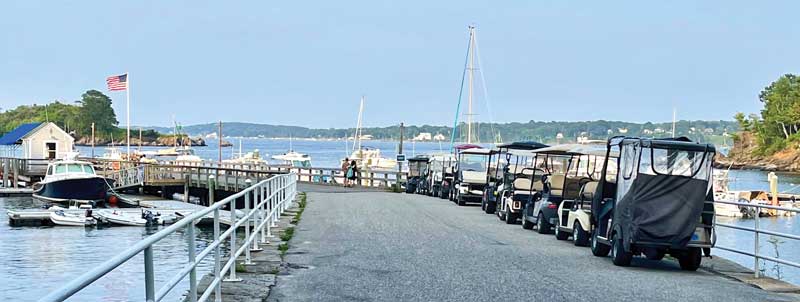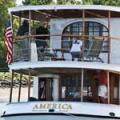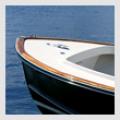Diamond Cove: Echoes of the Past
Photos by Mimi Bigelow Steadman
 Former officers’ residences stand at one end of Fort McKinley’s parade ground on Great Diamond Island.
Former officers’ residences stand at one end of Fort McKinley’s parade ground on Great Diamond Island.
The words “Maine island” usually suggest images of weathered houses and rugged fishing harbors. But last summer, we took a half-hour ferry ride on Casco Bay from Portland to Diamond Cove, on the northeastern end of Great Diamond Island, and entered an entirely different Maine island scene.
From the dock, where a lineup of golf carts awaited their owners’ return from the mainland, we walked uphill on leafy Diamond Avenue—really no more than a paved lane. After about a quarter mile, we came to a broad, grassy expanse surrounded by impressive Colonial Revival-style redbrick buildings fronted with white porches. Originally a parade ground, the parklike sward lies at the heart of Fort McKinley, the largest of five U.S. Army compounds that were built in Casco Bay in the late 19th and early 20th centuries.
 Golf carts on the ferry dock await Diamond Cove residents’ return from the mainland.
Golf carts on the ferry dock await Diamond Cove residents’ return from the mainland.
We had arrived for a peaceful, overnight getaway at the Inn at Diamond Cove, located in a place once specifically designed to keep the peace. Intended to repel assaults from the sea, construction of Fort McKinley began in 1890, with the first large gun battery completed in 1897 and a full array of armaments in place by 1905. Part of The Harbor Defenses of Portland, it boasted a total of nine batteries of massive guns capable of striking enemy ships as far as 10 miles away. The fort was active in time for the Spanish-American War in 1898, and was used during both World Wars. Troop numbers at the fort swelled to some 1,400 during World War II. McKinley was abandoned by the Army in 1947; its administration was passed to the Navy in 1954, and according to the Fort McKinley museum website, the property was sold to private owners in 1961.
Following decades of deterioration, the complex of nearly 50 buildings was reborn in the early 2000s as an inviting residential community.
Listed on the National Register of Historic Places, the former officers’ quarters, barracks, storehouses, and other structures are now private homes to several hundred residents, most of them seasonal. In 2013, a double barracks was being converted to a luxury hotel when it was devastated by fire. But construction inside the burned-out brick shell continued, and the Inn at Diamond Cove opened in 2015. It took us a while to determine which building it was and to locate the entrance, tucked on the side to maintain the façade’s historic appearance.
It was an unusually hot, humid day, and by the time we’d walked up the hill and finally found the lobby, my intentions of hiking to a beach, or trying out a bowling alley in the century-old game room, had dissolved in a puddle of sweat. The pool, just across the way, beckoned. We were soon enjoying a dip and a lazy afternoon.
From our lounge chairs, we spied a curious structure built into a berm in the woods. We’d learn more about it the next morning from Charles Goldberg, a volunteer with the small Fort McKinley Museum. I’d requested a tour in advance. When he confirmed, Goldberg added, “It just so happens that a resident is having a Happy Hour, open to everyone, the day you arrive.” When I asked whether I should say that he’d invited us, he replied, “You can, but nobody will ask.”
He was right: Strolling to dinner at the waterside restaurant, Diamond’s Edge, we paused at the lively party behind one of the houses. Any gatecrashing concerns vanished as people immediately welcomed us, inviting us to enjoy the band and the potluck spread of food and drink.
Picking us up in his golf cart in the morning, Goldberg explained that the structure near the pool had once housed the island’s telephone exchange. Setting it partially into the ground provided crucial fortification, as all communication between soldiers on lookout and those manning the guns was conducted via phone.
Goldberg drove us to several abandoned batteries and detailed how the guns operated. He also stopped at multiple buildings to explain their former functions. Ending at the museum, we studied photos and equipment that revealed the lives and duties of personnel once stationed here.
While the soldiers never saw combat, it was no doubt a demanding posting, and I’m guessing they weren’t sad when they left. We, on the other hand, could have happily stayed longer at Diamond Cove—on a unique Maine island where peace and hospitality commingle with intriguing echoes of the past.
Contributing Editor Mimi Bigelow Steadman lives on the Damariscotta River in Edgecomb.
If You Go to Diamond Cove
On the Water
It’s a short jaunt from Portland to Diamond Cove, making the island a popular destination for lunch or dinner, as well as overnights at The Inn at Diamond Cove. Getting there is half the pleasure: The half-hour trip follows a scenic route past several other islands before arriving at Diamond Cove. The easiest and cheapest way to go is aboard one of Casco Bay Lines’ red- and yellow-striped ferries, which make multiple daily trips. Two taxi services—Fogg’s Water Taxi and Portland Sea Taxi—also transport guests to the island. If you’re arriving on a private boat, plan to tie up at Diamond’s Edge Marina (12 feet alongside the dock). For overnight dockage during the summer, call ahead (207-766-5694).
Dine
Lunch or dinner at Diamond’s Edge restaurant is a highlight of a visit to Diamond Cove. Set in the former quartermaster’s storehouse just a few steps from the dock, it offers a refined menu that’s served on the waterside lawn and deck in good weather, as well as indoors. A little farther along Diamond Avenue is Crown Jewel, a pleasing eatery with a slightly funky vibe in the old blacksmith’s shop. There is also a casual dining spot and bar just off the lobby at the inn. All establishments are seasonal.
Do
A golf-cart tour of Fort McKinley with a knowledgeable, entertaining guide makes a visit to the island a far richer experience. As the Diamond Cove community is private, day visitors are only permitted to explore the fort’s grounds while on a guided tour; overnight guests of the inn are welcome to walk around on their own. Tours include a visit to the Fort McKinley Museum, in the former quartermaster’s office near the dock. Suggested donation is $10 per person. Tour reservations must be made in advance at: fortmckinleymuseum.weebly.com/arrange-a-tour.html.
Hike and Paddle
Hiking and walking trails meander through the island’s old-growth forest. If you are staying at the inn, ask for directions to the trails. The inn also rents kayaks and bikes to guests.
Stay
With its proximity to Portland and frequency of ferry trips, Diamond Cove is an appealing day-trip destination. For the full experience, plan to stay the night. The Inn at Diamond Cove offers a variety of luxury rooms and suites, most with balconies, built into a former double barracks overlooking the parade ground. The inn owns the Diamond’s Edge restaurant. Open May through September. Private rentals can also be found on the island.
Related Articles
Share this article:
2023 Maine Boat & Home Show

Join Us for the Maine Boat & Home Show!
Art, Artisans, Food, Fun & Boats, Boats, Boats
August 11 - 13, 2023 | On the waterfront, Rockland, Maine
Click here to pre-order your tickets.
Show is produced by Maine Boats, Homes & Harbors magazine.















